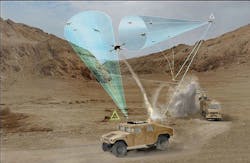Army surveys industry for companies to design vehicle-mounted sensors to detect and destroy small UAVs
Officials of the Army Contracting Command-New Jersey at Picatinny Arsenal, N.J., issued a request for information on Thursday (W15QKN19X05YK) for the Ballistic Low Altitude Drone Engagement (BLADE) 360 Degree Detection System.
The goal is to design vehicle-mounted sensors able to detect Group 1 UAVs over 360 degrees while the host vehicle is moving or parked. A Group 1 UAV weighs less than 20 pounds, can fly as high as 1,200 feet above the ground, at speeds slower than 100 knots.
The Army Contracting Command is issuing this request for information on behalf of the Army Combat Capabilities Development Command (CCDC) Armaments Center at Picatinny Arsenal.
Related: The new world of counter-drone technology
The sensor must be able to provide real-time alerts to targeting radar aboard nearby vehicles, helicopters, fixed-wing aircraft, of fixed sites. The cueing sensor could be radar or electro-optical sensors, and must be mountable to a wide variety of Army combat vehicles, ranging from Humvees to Abrams main battle tanks.
Army researchers want the UAV-detecting cueing sensor to be small, lightweight, affordable, and suitable for stationary and on-the-move operations.
Initial prototype sensors must be able to detect small UAVs out to a distance of nearly two miles; localize the target in azimuth and elevation to an accuracy of about 7.5 degrees; update at a rate of 1 Hz; be able to track five targets at once; must be able to differentiate small UAVs from birds; and work during the day, at night, and in bad weather.
Sensors should work on no more than 1 kilowatt of vehicle power; must be industrial-ruggedized; and provide data through standard communications channels.
Related: RF and electro-optical sensors with airborne drone and target detection introduced by FLIR
Ultimately, Army researchers want a sensor that can localize the target within 7.5 degrees azimuth and elevation; detect targets at distances as far as more than three miles; detect at least 10 targets simultaneously; and be ruggedized to military specifications.
From industry, Army experts want to know how long it would take to develop such a cueing sensor; realistic enabling technologies; approximate costs; and alternatives for design approaches.
Companies interested should email white papers no longer than 30 pages, and no later than 10 May 2019, to the Army's Antonius Gill at [email protected] and to Elizabeth Horak at [email protected].
For questions or concerns contact Antonius Gill by email at [email protected], or by phone at 973-724-2683. More information is online at https://www.fbo.gov/notices/295f8755e33d97ad9e0005273d1fbb56.
Ready to make a purchase? Search the Military & Aerospace Electronics Buyer's Guide for companies, new products, press releases, and videos
